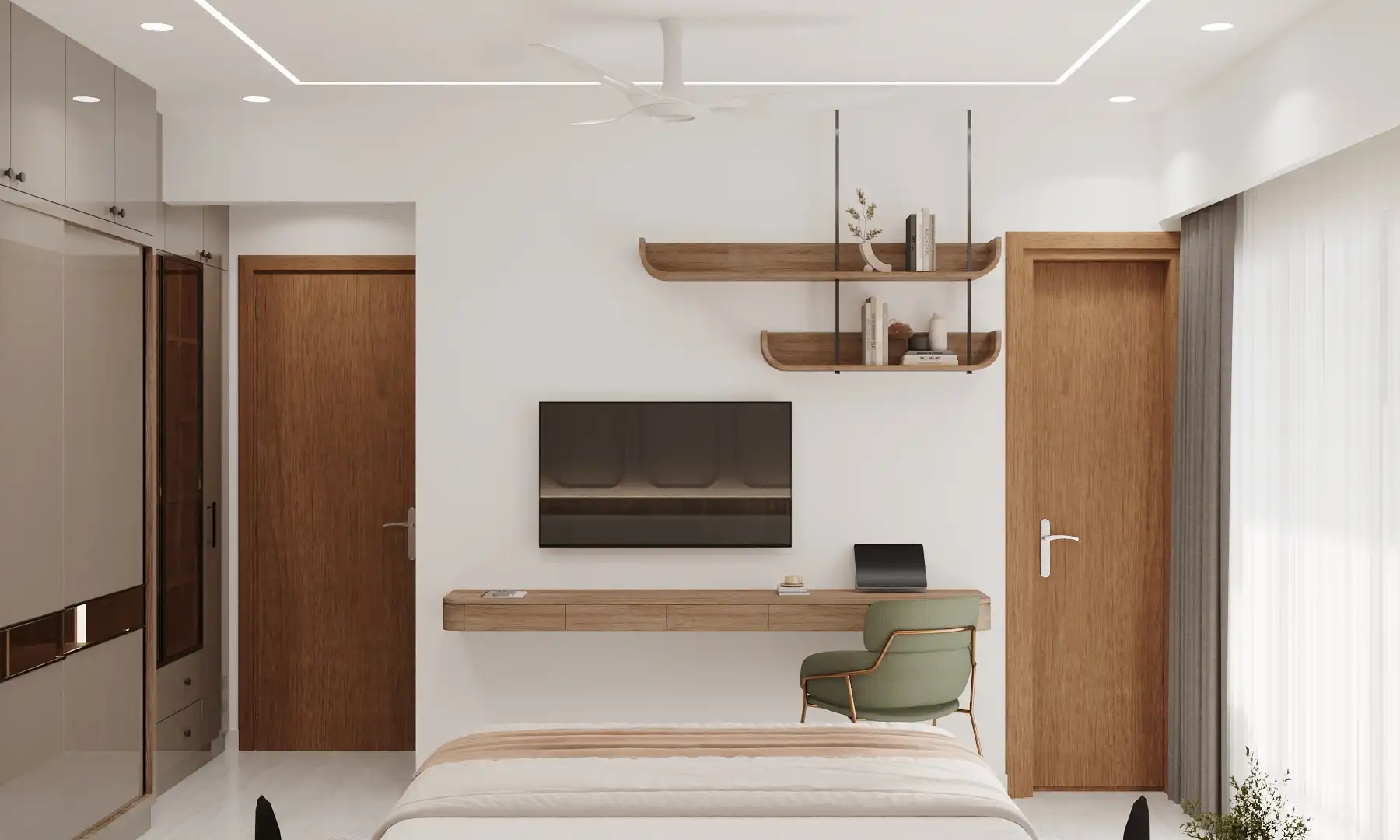What is the Best Way to Arrange Furniture in a Small Study Room?
Introduction
Arranging furniture in a small study room can be quite a challenge, especially when you want to create a space that feels open, organized, and functional. Whether you’re setting up a home office or a study nook for your children, the right furniture arrangement can make a significant difference in terms of comfort, productivity, and aesthetic appeal.
The key to optimizing your small study room lies in maximizing the available space, using the right furniture pieces, and arranging them thoughtfully. By combining expert design principles and creativity, you can transform a cramped room into a functional and visually appealing space. In this article, we’ll walk you through the best practices for arranging furniture in a small study room, with tips from luxury interior designers in Bangalore and insights on creating a perfect setup.
1. Start with the Right Furniture Pieces
When dealing with a small space, it’s crucial to choose furniture that is compact yet functional. Here are some tips for selecting the right furniture pieces for your study room:
- Opt for Multi-Functional Furniture: Look for furniture that can serve multiple purposes. For example, a study table with built-in storage or an ergonomic chair that doubles as extra seating can help you save space.
- Choose Sleek, Minimalist Designs: Go for minimalist furniture with clean lines and simple designs. These pieces tend to blend seamlessly into smaller rooms, creating an uncluttered look.
- Use Vertical Storage: In a small study room, wall-mounted shelves, floating desks, or high cabinets can help you store books and supplies without occupying valuable floor space.
2. Define the Room’s Function
Before deciding how to arrange the furniture, take time to consider how you want to use the study room. Understanding the purpose of the space will guide your furniture layout and allow you to prioritize essential items. Ask yourself:
- Will the room be used for studying, working, or both?
- Do you need extra space for meetings or creative activities?
- Do you require specialized furniture like a drawing board or a standing desk?
Once you define the room’s function, you’ll have a clear vision for which furniture pieces are absolutely necessary. For example, if the room is primarily for studying, you may focus on a desk and storage solutions, whereas if it serves as a multifunctional workspace, you might need more seating arrangements and larger storage units.
3. Optimize the Layout for Workflow
The key to arranging furniture in a small study room is ensuring that the flow of the room complements your workflow. This involves setting up your furniture in such a way that allows easy movement and minimizes distractions. Consider the following layout tips:
- Desk Placement: Ideally, place your desk near a window to take advantage of natural light. If possible, position the desk against a wall to create a sense of focus and privacy. Avoid placing it in the middle of the room, as this can make the space feel more cluttered.
- Use Corners: Small study rooms often have underutilized corners. Corner desks or a chair in the corner can free up central space while providing a cozy and efficient workspace.
- Create Zones: If your study room has a dual purpose, create separate zones for studying and relaxation. A well-positioned armchair, for example, can act as a reading corner, distinct from your main study area.
4. Maximize Vertical Space
In a small room, floor space is often limited, which is why it’s essential to make use of vertical space. By going upward, you can store books, files, and office supplies without cluttering the floor. Here are some vertical design ideas:
- Wall-Mounted Shelves: Install shelves above your desk to hold books, decor, or personal items. Floating shelves offer both aesthetic appeal and practicality without taking up floor space.
- Tall Storage Units: Consider tall filing cabinets or cupboards to store paperwork, stationery, or other supplies. These options provide ample storage without occupying much of the floor.
- Vertical Wall Art: Adding framed artwork or posters on the walls helps create a personal touch without consuming space on your desk or shelves.
5. Choose the Right Furniture Size
The size of your furniture plays a vital role in how spacious the room feels. Oversized furniture can make a small room feel cramped, so it’s important to choose the right scale. When selecting furniture for your study room, keep these points in mind:
- Desk Size: Choose a desk that’s proportionate to the size of the room. A bulky desk can overwhelm a small space, while a slim, functional desk will maintain the room’s flow.
- Chair Selection: Opt for an ergonomic chair that provides support but doesn’t take up too much space. A compact, swivel chair will allow you to move freely around your desk without obstructing the room.
- Storage Solutions: Instead of large, bulky bookshelves, choose smaller, modular storage units or file organizers. These will provide ample storage without dominating the space.
6. Incorporate Smart Lighting
Lighting plays a crucial role in creating a functional study room. A well-lit environment helps improve productivity and reduces eye strain. Here are some lighting ideas for your small study room:
- Task Lighting: Ensure that your desk is well-lit with a quality desk lamp. Adjustable lamps provide focused light for reading, writing, or working on your computer.
- Ambient Lighting: A combination of ceiling lights and wall-mounted lamps can help brighten the room without overpowering the space.
- Natural Light: Make the most of natural light by positioning your desk near a window. Natural light not only improves mood but also reduces the need for artificial lighting during the day.
7. Keep the Space Clutter-Free
A cluttered study room can hinder your focus and productivity. It’s essential to keep the room organized by choosing the right storage options. Here’s how to keep your small study room tidy:
- Use Drawer Organizers: Desk drawers and filing cabinets can easily get cluttered. Use dividers or small boxes to keep stationery, papers, and supplies organized.
- Cable Management: Ensure that wires and cables are neatly hidden using cable organizers or clips. This keeps the desk area clean and minimizes distractions.
- Minimalist Decor: Keep decorations to a minimum to avoid overwhelming the space. Focus on a few key pieces, such as a potted plant or an inspiring quote, to add personality to the room.
8. Create a Relaxing Atmosphere
A study room is not just a workspace—it should also be a place where you can relax and recharge. A few thoughtful touches can make the room more inviting and pleasant. Consider the following:
- Add Greenery: A small indoor plant or succulent can brighten up the room and improve air quality, making it a more pleasant space to study.
- Comfortable Accessories: Throw pillows or a soft rug can add comfort and warmth to the space, making it feel more inviting.
- Soothing Colors: Opt for calming, neutral colors for the walls and furniture. Soft blues, whites, or earthy tones can help create a peaceful and focused atmosphere.
9. Leverage Professional Help
When designing a small study room, getting the right advice can make a huge difference in how effectively the space is utilized. Hiring luxury interior designers in Bangalore or working with the best interior designing company in Bangalore can help you make the most of your limited space. Professionals will consider factors like lighting, furniture layout, storage solutions, and color schemes, all while ensuring the room remains functional and stylish.
Conclusion
Arranging furniture in a small study room requires a balance of style, functionality, and organization. By choosing the right furniture pieces, optimizing the layout, and making smart use of vertical space, you can transform even the smallest room into an efficient and aesthetically pleasing workspace. Keep your room clutter-free, incorporate smart lighting, and consider expert advice from best interior designing company in Bangalore to create a study room that fosters productivity and creativity. By following these tips, your study room will become not just a place to work but an inspiring, comfortable, and well-organized environment that you’ll enjoy spending time in.














Post Comment